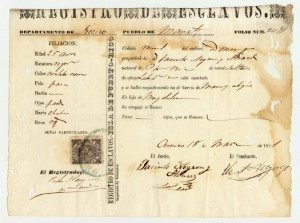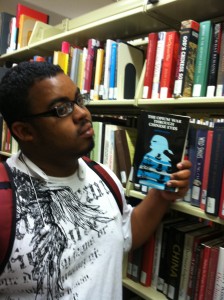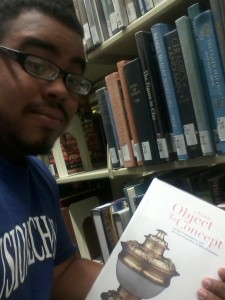El Registro de Esclavos de Puerto Rico was a product of the 1870 law which granted freedom to certain slaves. This document, and another like it, can be found at the British Museum.
All posts by almodovt
Shelfie #2
Waley, Arthur. The Opium War through Chinese Eyes. Stanford, CA: Stanford UP, 1958. Print.
The book I chose for this shelfie is The Opium War Through Chinese Eyes, written by Arthur Waley. I found this book using the search term “opium war” in the library catalog, although I was looking for more information through a different perspective. In class we discussed what the Opium War meant for global trade, but history is often written from the perspective of the “winner.” For this reason, I chose to look for a book that would give more insight into the Chinese experience of the Opium War. The title of this book stood out to me as an opportunity to do just that. Waley begins with an edited version of Comissioner Lin’s diary from 1839-41. In the diary, Lin discusses opium within the context of his multiple occupations and interests. Waley continues the book by talking about the events during war-time from the perspective of Chinese men. He also provides many interesting insights into Chinese-British relationships. I found this book in a shelf full of books on the Opium War; looking through these books may also provide more perspectives on the war that is not achievable from just the Empires textbook.
From Object to Concept
Book Information: Pierson, Stacey. From Object to Concept: Global Consumption and the Transformation of Ming Porcelain. Hong Kong: Hong Kong UP, 2013. Print.
Trade has been a very important part in class readings and discussions, so I wanted to look for a book that reflected that. In addition, our last reading involved East Asian empires and how they were involved in an interconnected world. Interestingly, I found this book while searching under the keywords “Qing” and “trade.” Because this book is about Ming porcelain and global consumption, it reminded me of the Kakiemon Elephants from Japan. However, another reason why I chose this book was that it looked like it might tie in how Ming porcelain was treated in the modern world, and how that has changed from its conception (or as the book title properly labels it- the transformation from object to concept). Pierson begins with the conception of Ming porcelain between the 14th and 17th century. She writes about how porcelain is manufactured and its’ function. She goes on to describe how Ming porcelain went on to be distributed globally, and the different reactions people had depending on where they came from (Europe, Africa, west and south Asia. Pierson also talks about what Ming porcelain meant to Europe as a linguistic invention. Finally, Pierson discusses Ming porcelain as it relates to the Art world since the 19th century. This book essentially covers the time line of Ming Porcelain in a way that best highlights the importance of Porcelain in a specific time period, as well as why it was (and is) important.
Interesting titles near From Object to Concept: There were a lot of books on Chinese porcelain and consumption, which leads me to believe that these books not only cover Ming porcelain and trade, but other dynasties as well.


